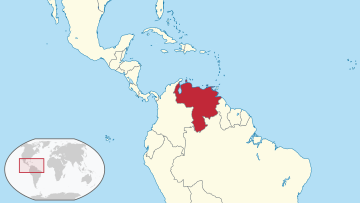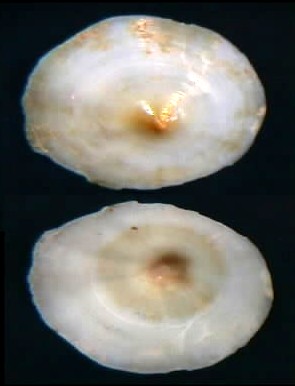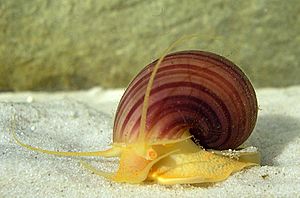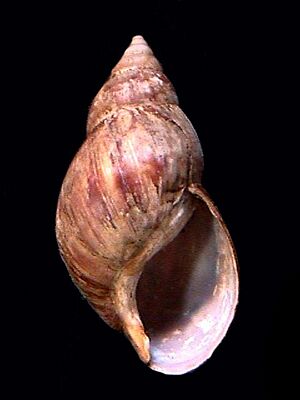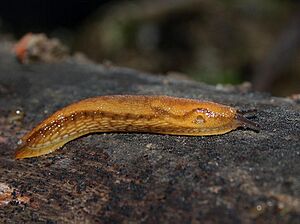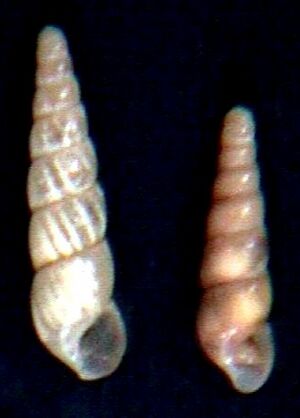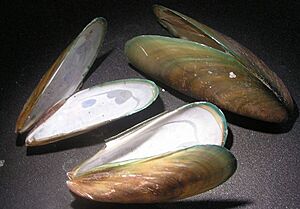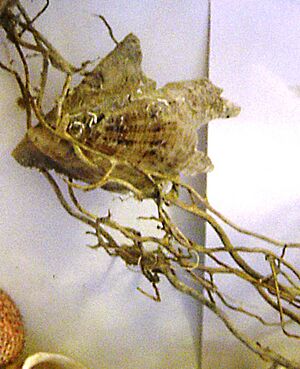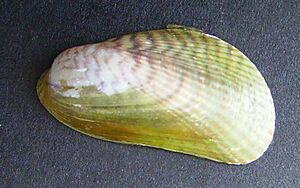List of introduced molluscs of Venezuela facts for kids
Imagine tiny creatures that don't naturally belong in a place, but somehow they end up living there and making it their new home. These are called introduced species. In Venezuela, scientists have found 52 different types of molluscs that were brought there from other parts of the world. Molluscs are a group of soft-bodied animals, many of which have shells, like snails, slugs, clams, and mussels.
These introduced molluscs can be found in different environments:
- Marine snails: 7 species live in the ocean.
- Freshwater snails: 5 species live in rivers and lakes.
- Land snails and slugs: 22 species live on land.
- Marine clams and mussels: 18 species live in the ocean.
- Estuarine clams and mussels: 2 species live where rivers meet the sea.
In total, 52 different kinds of molluscs have been introduced to Venezuela. It's important to keep track of them because they can sometimes affect the local plants and animals.
Contents
Snails and Slugs (Gastropods)
Gastropods are a large group of molluscs. They include snails, which usually have a single coiled shell, and slugs, which often have no shell or a very small internal one. Many of the introduced molluscs in Venezuela are gastropods.
Marine Snails
These snails live in the salty waters of the ocean. They might have arrived in Venezuela by hitching a ride on ships or through other human activities.
One example is the Umbraculum plicatulum, which has a unique, flat shell that looks a bit like a mushroom cap.
Other marine snails found include:
- Babylonia aerolata
- Fusinus barbarensis
- Fusinus marmoratus
- Modulus cerodes
- Vasum ceramicum
Freshwater Snails
These snails live in freshwater environments like rivers, lakes, and ponds. Some freshwater snails are popular in the aquarium trade, and they might escape or be released into the wild.
A well-known example is the Pomacea canaliculata, also known as the channeled apple snail. These snails can grow quite large and are sometimes seen as a pest because they can eat rice crops.
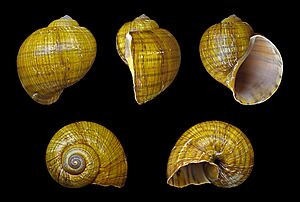
Another common freshwater snail is Melanoides tuberculata, or the red-rimmed melania. This snail can reproduce very quickly and sometimes carries parasites that can affect humans or animals.
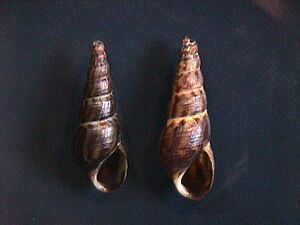
Other introduced freshwater snails are:
- Pomacea bridgesi
- Planorbella duryi
- Thiara granifera
Land Snails and Slugs
Land gastropods live on dry land, often in gardens, forests, or agricultural areas. Many of these species are accidentally moved around the world through trade or travel.
One of the most famous introduced land snails is the Achatina fulica, also known as the giant African snail. It's one of the largest land snails in the world and can cause a lot of damage to crops. It can also carry diseases.
Slugs, like Arion subfuscus (the dusky slug) and Deroceras reticulatum (the grey field slug), are also found. Slugs don't have a visible shell and prefer moist environments. They can also be pests in gardens.
The garden snail, Cornu aspersum, is another common introduced species. It's often found in gardens and can eat plants.
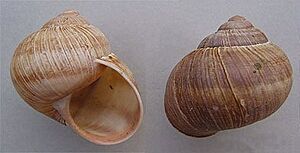
Here are some other introduced land snails and slugs:
- Bradybaena similaris
- Cecilioides acicula
- Cecilioides aperta
- Cepaea
- Helix pomatia
- Otala
- Theba pisana
- Agriolimax laevis
- Lehmannia valenciana
- Milax gagatex
- Gulella bicolor
- Allopeas micra
- Lamellaxis mauritianus
- Opeas gracile
- Opeas pumilum
- Opeas pyrgula
- Subulina octona
- Subulina striatella
Clams and Mussels (Bivalves)
Bivalves are molluscs that have two shells, or "valves," that are hinged together. This group includes clams, mussels, and oysters. Like gastropods, they can be introduced to new places by human activities.
Marine Clams and Mussels
These bivalves live in the ocean. Some are important for food, but introduced species can sometimes compete with native ones for resources.
The Perna perna (brown mussel) and Perna viridis (Asian green mussel) are examples of introduced marine mussels. They can attach to structures like docks and ships, and they might outcompete native mussels.
The Placuna placenta, also known as the windowpane oyster, has a very thin, flat shell that was once used to make windowpanes.
Other introduced marine bivalves include:
- Arca pacifica
- Donax clathratus
- Mactronella exoleta
- Rangia mendica
- Gregariella corallophiga
- Pteria hirundo
- Cumingia lamellosa
- Strigilla pseudocarnaria
- Lyodus pedicellatus
- Bankia carinata
- Bankia martensi
- Thracia distorta
- Cincomphalus strigillinus
- Clausinella gayi
- Clausinella fasciata
Estuarine Clams and Mussels
Estuaries are special places where freshwater from rivers mixes with saltwater from the sea. These areas are very important for many animals.
The Corbicula fluminalis, or Asian clam, is an introduced species often found in estuaries and freshwater rivers. It can reproduce quickly and form dense populations.
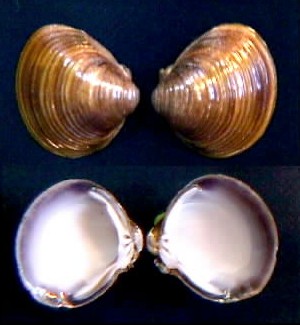
Another estuarine mussel is Musculista senhousia, also known as the Asian bag mussel. It can also form large groups and change the environment where it lives.
Why are Introduced Species Important?
When a new species is introduced to an area, it can sometimes become invasive. This means it spreads quickly and can cause problems for the native plants and animals. They might compete for food, space, or even introduce new diseases. Learning about these introduced molluscs helps scientists and conservationists understand how to protect Venezuela's natural environment.
See also
 In Spanish: Moluscos introducidos en Venezuela para niños
In Spanish: Moluscos introducidos en Venezuela para niños
- List of echinoderms of Venezuela
- List of Poriferans of Venezuela
- List of marine molluscs of Venezuela
- List of molluscs of Falcón state, Venezuela
- List of non-marine molluscs of El Hatillo Municipality, Miranda, Venezuela
- List of non-marine molluscs of Venezuela
- List of birds of Venezuela
- List of mammals of Venezuela


